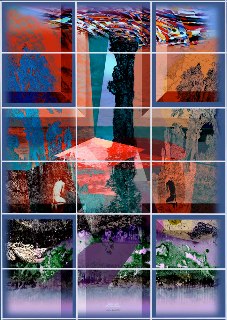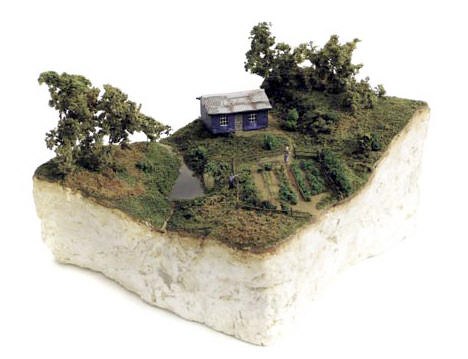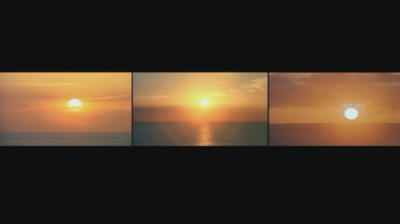|
|
| home | features | exhibitions | interviews | profiles | webprojects | gazetteer | links | archive | forum |
|
SuperNature: a response Patrick Brandon
The destructive/creative collision is a theme that arches across this energetic and varied group show. With Stox’s work, a signal is received and beautifully scrambled - giving a mineral feel to digitized play. Surface topography gives way to geology, to astronomy, to the arcane, and to bold detailing that brings to mind traditions beyond immediate recognition. Video and painting are put into fragile dialogue in Simon Jacques’ pairing of mini plasma-screen and canvas. A storm filmed on a mobile camera seems to struggle for stillness rather than movement, while, in contrast, the painting placed in opposition aches for movement. His photo pieces, From The Car and Lampost collection and translation create a poetic gap, a sense of moving through a world of experience and memory in which we play no part, as if we are moving in a night we have no chance of possessing.
Ebel’s work seems to find continuation in Marion Taylor’s graphite and carborundum pieces where the worked surface applies a varying grip or tread. This kind of unrehearsed dialogue is exhilarating. Paul Chaney’s hermetically sealed scenes offer no possible exits or entrances. In SW774318 we find four shipping containers stacked as neat as gaming chips or Jenga pieces. A cluster of trees, a hanged man, a suited and booted figure at ground level staring out to space. This particular endgame is a scenario-generator. We have an edit, a geological slice, but infinite possibilities lay outside of it.
Kaisa Karikloski strokes at the material world until it is smoothed to a near invisibility, a paradoxical suggestion of the monolithic coaxed from close study. Roots Together has a sensuality that cannot be diminished through reductive blending. These are generous paintings. In Rupert White’s Meadow six stalks of grass
interconnect, their rhizoids replaced with thin lengths of stainless
steel. Its rightness is tested by the opposition of the materials. The
natural and the imposed are spliced. A weird form of grafting is alluded
to in the video piece, Trinity (picture left), which refers to the
Relative scale permeates the work of Jesse Leroy Smith. His are small, even discreet paintings. Yet they have a sense of movement and space that far exceeds their occupancy. Perversely, these are enormous works. There are no illusionistic games at play. In Giant there are no comparative dimensions set out for us. The reflective surfaces of copper and mirror are both wall and window. A mix of play and wit tempered with a deep seriousness. We go on trust and feel.
James Hankey conflates the stride with the scratch-work the hand might make over the photo surface, a retinal tracking as the eye moves over the landscape. Carrying a torch across a lunar lit landscape, the long exposure where two light sources vie for a kind of dominance, he creates works that seem to consume itself. Here the artist is messenger delivering a descriptive tract in all senses of the word.
Supernature was at View Gallery, Bristol 12/8/09 - 27/9/09. See also exhibition review with installation views. Patrick Brandon's most recent collection of poetry is published by Bloodaxe:
|
|
|

 Asteroid
22369 Klinger, by Volker Stox is named after the German Symbolist
painter Max Klinger (1857-1920), often cited as an important bridge
between symbolism and the surrealist movements of the last century.
Klinger is also cited in Stox’s piece Faith Cube (picture right), which samples
a kneeling figure, negatived and supplicatory.
Asteroid
22369 Klinger, by Volker Stox is named after the German Symbolist
painter Max Klinger (1857-1920), often cited as an important bridge
between symbolism and the surrealist movements of the last century.
Klinger is also cited in Stox’s piece Faith Cube (picture right), which samples
a kneeling figure, negatived and supplicatory. Tracy
Ebel presents the world read through the constriction and reversals of a
camera obscura. Each image comes into being as if on a drop of blood
which swells and bends the world around it in electroplate. After we are
drawn into the stepped intimacy of two landscapes: Circular Pond,
Tree Line and two companion close-ups Mimosa, Geranium, we
move on to the beautiful yawn and stretch of Boat.
Tracy
Ebel presents the world read through the constriction and reversals of a
camera obscura. Each image comes into being as if on a drop of blood
which swells and bends the world around it in electroplate. After we are
drawn into the stepped intimacy of two landscapes: Circular Pond,
Tree Line and two companion close-ups Mimosa, Geranium, we
move on to the beautiful yawn and stretch of Boat. 

 Lloyd Durling has slowed his heartbeat to such a degree
that our time flows rapidly around his hand. Into the Forest is
stilled and furred with detail upon detail, while the shift in intensity
and direction in Falling Further and Further (picture right) disorients and
delights in equal measure. These are, in many ways, badlands rather than
candy-lands, with enough dark energy to tension the lightness which on
first inspection dominates. They have that request of closer;
closer still which tradition teaches us will lead to a bad end. Yet closer
we are compelled to get.
Lloyd Durling has slowed his heartbeat to such a degree
that our time flows rapidly around his hand. Into the Forest is
stilled and furred with detail upon detail, while the shift in intensity
and direction in Falling Further and Further (picture right) disorients and
delights in equal measure. These are, in many ways, badlands rather than
candy-lands, with enough dark energy to tension the lightness which on
first inspection dominates. They have that request of closer;
closer still which tradition teaches us will lead to a bad end. Yet closer
we are compelled to get.